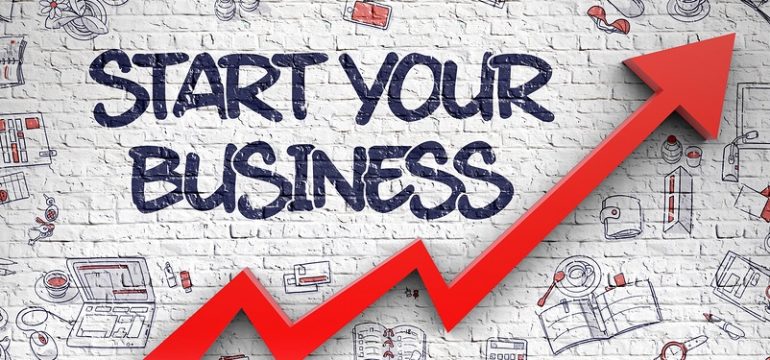
Why start your own business?
There are many reasons why people decide to start their own business. Some people start their own business because they want to be their own boss and have the freedom to make their own decisions. Others start a business to pursue a passion or idea that they are excited about. Some people start a business to achieve financial independence and increase their income. Others start a business because they see an opportunity to fill a need or solve a problem in the market. Ultimately, the decision to start a business is a personal one, and people are motivated by a variety of factors.
Starting your own business can be a rewarding and exciting experience, but it can also be overwhelming and stressful. There are many steps to consider and tasks to complete before you can get your business off the ground. Here are 10 steps to help guide you through the process of starting your own business in the UK:
1. Develop a business plan:
A business plan is a detailed document that outlines your business goals, target market, marketing strategy, financial projections, and other key details. It serves as a roadmap for your business, helping you stay focused and organized as you start your business.
There are several key components that should be included in a business plan:
- Executive summary: This is a brief overview of your business, including your mission statement, target market, and unique selling proposition.
- Market analysis: This section should include information about your industry, target market, and competitors. It should also discuss any trends or changes that may impact your business.
- Marketing strategy: Your marketing strategy should outline the methods you will use to reach your target market and promote your products or services. This could include things like social media marketing, email marketing, or traditional advertising methods.
- Financial projections: This section should include detailed financial projections for your business, including your income statement, balance sheet, and cash flow statement. These projections should be based on your target market, pricing strategy, and marketing efforts.
- Management team: This section should include information about the key members of your management team, including their experience and qualifications.
- Operations plan: This section should outline the day-to-day operations of your business, including your production process, supply chain, and any other key details.
Overall, a business plan is an essential tool for any business owner, as it helps you define your business goals, target market, and marketing strategy, and it also serves as a reference point as you navigate the challenges of starting and growing your business.

2. Choose a business structure
Choosing the right business structure is an important decision as it can have significant legal and financial implications for your business. There are several different business structures to choose from in the UK, including:
- Sole trader: This is the most simple and common business structure in the UK. As a sole trader, you are the sole owner of your business and are personally responsible for all aspects of the business, including any debts or liabilities.
- Partnership: A partnership is a business structure in which two or more people operate a business together. Partnerships can be either general partnerships, where all partners are equally responsible for the business, or limited partnerships, where some partners have limited liability.
- Limited company: A limited company is a business structure in which the company is a separate legal entity from its owners. This means that the owners (called shareholders) have limited liability for the company’s debts and liabilities. Limited companies can be either private (owned by a small group of individuals) or public (owned by a large group of shareholders).
- Limited liability partnership (LLP): An LLP is a business structure that combines elements of a partnership and a limited company. Like a partnership, an LLP has multiple owners (called partners) who are personally responsible for the business. However, like a limited company, the partners have limited liability for the LLP’s debts and liabilities.
When choosing a business structure, it’s important to consider factors such as your personal liability, tax implications, and the level of complexity and paperwork involved. It may be helpful to consult with a solicitor or accountant to determine which business structure is right for you.

3. Choose a business name
Choosing a business name is an important step in starting your own business, as it will become your brand identity. Here are some things to consider when choosing a business name:
- Make it unique: Your business name should be unique and distinguishable from other businesses in your industry. This will help you stand out from the competition and make it easier for customers to remember your business.
- Keep it simple: A simple, easy-to-pronounce business name is more likely to stick in people’s minds. Avoid using complicated or hard-to-spell words in your business name.
- Make it relevant: Your business name should be relevant to your products or services. This will help customers understand what your business is all about and make it easier for them to find you when searching online.
- Consider your target market: Think about your target market and the image you want to convey with your business name. A more formal, professional name may be appropriate for a business-to-business company, while a more casual, playful name may be suitable for a consumer-oriented business.
- Check for availability: Before you settle on a business name, be sure to check that the name is available to use. You can do this by searching online directories, checking with Companies House, and performing a trademark search to ensure that the name is not already in use or protected by someone else.
Overall, it’s important to put some thought and effort into choosing a business name that reflects your business and resonates with your target market.
4. Register your business
In the UK, you need to register your business with Companies House, which is the government body responsible for registering and regulating businesses. This process involves completing some paperwork and paying a fee. Here are the steps for registering your business with Companies House:

- Determine which business structure you will use: As mentioned earlier, there are several different business structures to choose from in the UK, including sole trader, partnership, limited company, and limited liability partnership (LLP). Each has its own advantages and disadvantages, so it’s important to determine which one is right for you.
- Choose a business name: You will need to choose a business name that is unique and appropriate for your business. Make sure to check that the name is available to use by searching online directories and performing a trademark search.
- Complete the necessary paperwork: Depending on your business structure, you will need to complete different forms to register your business with Companies House. This could include forms such as the IN01 (for registering a limited company) or the DS01 (for registering a limited liability partnership).
- Pay the fee: There is a fee to register your business with Companies House, which varies depending on your business structure and the type of registration you are completing.
- Submit the paperwork: Once you have completed the necessary forms and paid the fee, you will need to submit your paperwork to Companies House. You can do this online or by mail.
- Wait for confirmation: After you have submitted your paperwork, Companies House will review it to ensure everything is in order. Once your registration is approved, you will receive confirmation and your business will be officially registered.
It’s important to note that registering your business with Companies House is just one step in the process of starting a business. You may also need to register for taxes, get insurance, and take care of other legal and administrative tasks.
5. Get a business bank account
It’s important to keep your personal and business finances separate, so you should get a business bank account as soon as possible. This will make it easier to manage your business finances and track your income and expenses. Here are some steps for setting up a business bank account
Check out our blog post on why getting a business account is important here:
Why You Need A Business Bank Account For Your Business
Also, don’t forget to check out our EXCLUSIVE offer for a FREE Business Bank Account with £75 FREE Cash and FREE Limited company formation if required here:
Tide Bank Review & Tide Referral Code: REFER75 – Get £75 FREE
- Research different banks: There are many banks to choose from, so it’s important to do some research and compare different options to find the one that best meets your needs. Consider factors such as fees, account features, and convenience.
- Gather the necessary documents: To set up a business bank account, you will need to provide some documents to the bank. This could include your business registration documents, identification, and proof of address.
- Choose an account type: Most banks offer a variety of business bank accounts, so you will need to choose the one that best meets your needs. Options could include a basic checking account, a merchant account for accepting credit card payments, or a more specialized account for a specific type of business.
- Set up online banking: Many banks offer online banking services that allow you to manage your account and make transactions online. Be sure to set this up when you open your account so you can easily access your account information and make transactions from anywhere.
- Set up automatic payments: To make it easier to manage your finances, consider setting up automatic payments for things like rent, utilities, and other regular expenses.
Overall, a business bank account is an essential tool for any business owner, as it helps you keep track of your finances and manage your money more effectively.

6. Register for taxes
In the UK, you will need to register for various taxes, including value-added tax (VAT), corporation tax, and income tax. The process for registering for taxes will vary depending on your business structure and the type of business you are starting. Here are some general steps to follow:
- Determine which taxes you need to pay: Different businesses are subject to different taxes, so it’s important to determine which taxes apply to your business. This will depend on your business structure, the products or services you sell, and your annual turnover.
- Register for VAT: If your annual turnover is more than £85,000, you are required to register for VAT. To register, you will need to complete the VAT1 form and submit it to HM Revenue and Customs (HMRC).
- Register for corporation tax: If you are starting a limited company or a limited liability partnership (LLP), you will need to register for corporation tax. To do this, you will need to complete the CT41G form and submit it to HMRC.
- Register for self-assessment: If you are a sole trader or a partner in a partnership, you will need to register for self-assessment. This is a process for declaring and paying your income tax. To register, you will need to complete the self-assessment registration form and submit it to HMRC.
- Keep track of your tax obligations: Once you are registered for taxes, it’s important to keep track of your tax obligations and make sure you are paying the correct amount on time. This could involve keeping accurate financial records and submitting tax returns on a regular basis.
Overall, it’s important to familiarise yourself with your tax obligations and make sure you are paying the correct amount of tax in a timely manner to avoid penalties and fines.
7. Get insurance
It’s important to protect your business with the right insurance coverage. This could include general liability insurance, employer insurance, property insurance, and business interruption insurance. Here are some steps to follow when getting insurance for your business:
- Determine your insurance needs: Different businesses have different insurance needs, so it’s important to assess your risks and determine what types of insurance are necessary for your business. This could involve consulting with an insurance broker or reviewing industry-specific guidelines.
- Shop around: There are many insurance providers to choose from, so it’s important to shop around and compare different options to find the best coverage for your needs. Consider factors such as price, coverage limits, and customer service.
- Read the policy carefully: Before you purchase an insurance policy, be sure to read it carefully and understand exactly what is covered and what is not. It’s important to make sure you are getting the coverage you need at a price you can afford.
- Keep your insurance up to date: As your business grows and changes, it’s important to review your insurance coverage regularly to make sure it still meets your needs.
Overall, insurance is an essential part of protecting your business and minimizing your risk. It’s important to take the time to research different options and choose the right coverage for your business.
8. Find a location
If you’re starting a brick-and-mortar business, you will need to find a suitable location for your business. Here are some things to consider when choosing a location:
- Accessibility: Consider how easy it is for customers to access your location, especially if you rely on foot traffic. Is your business located in a busy area with good foot traffic, or is it located in a more residential area that may be harder for customers to reach?
- Cost: The cost of your location will be a major factor in your decision. Consider factors such as rent, utilities, and other expenses when evaluating different locations.
- Size: Make sure the size of the location is appropriate for your business. It should be large enough to accommodate your needs, but not so large that it is unnecessarily expensive.
- Parking: If your business relies on customers coming by car, make sure there is adequate parking available.
- Visibility: Consider how visible your business will be from the street. A location with good visibility may be more attractive to potential customers.
Overall, it’s important to carefully evaluate different locations and consider a variety of factors before making a decision. The right location can have a major impact on the success of your business.
9. Get a website
Developing a website for your business is an important step in promoting your business online. A website allows you to showcase your products or services, provide information about your business, and connect with customers. Here are some steps to follow when developing a website for your business:
- Determine your website goals: What do you want to achieve with your website? Do you want to generate leads, make sales, or simply provide information about your business? Your goals will help guide the development of your website.
- Choose a domain name: Your domain name is the address of your website (e.g., www.yourbusiness.com). Choose a domain name that is easy to remember and reflects your business.
- Select a website builder: There are many different website builders to choose from, including WordPress, Wix, and Squarespace. Each has its own features and pricing plans, so it’s important to choose the one that best meets your needs.
- Design your website: Once you have a website builder and domain name, you can start designing your website. This could involve choosing a theme, adding pages, and customizing the layout and design.
- Add content: Your website should include relevant, useful content that helps visitors understand your business and what you offer. This could include things like product descriptions, company information, and blog posts.
- Test and launch your website: Once your website is complete, be sure to test it thoroughly to ensure everything is working properly. Then, you can launch your website and start promoting it to attract visitors.
Overall, a website is a valuable tool for any business, as it allows you to connect with customers and showcase your products or services online.
10. Develop a marketing strategy:
Developing a marketing plan is an important step in starting your own business. A marketing plan outlines your marketing strategy, target market, and marketing budget, and it helps you stay focused and organized as you promote your business. Here are some steps to follow when developing a marketing plan:
- Determine your target market: Identify the specific group of people that you want to reach with your marketing efforts. This could include factors such as age, gender, location, and interests.
- Define your unique selling proposition: What makes your business unique? What sets you apart from your competitors? Your unique selling proposition (USP) is what sets you apart and makes you stand out in the market.
- Identify your marketing channels: There are many different marketing channels available, including social media, email marketing, content marketing, and traditional advertising. Determine which channels are most appropriate for your business and your target market.
- Set marketing goals: Determine what you want to achieve with your marketing efforts. Your goals could include things like increasing brand awareness, generating leads, or making sales.
- Develop a budget: Determine how much you are willing and able to spend on marketing. Your budget will help you determine which marketing channels and tactics are feasible for your business.
- Create a content calendar: A content calendar helps you plan and schedule your marketing efforts in advance. It can include things like social media posts, email campaigns, and blog posts.
Overall, a marketing plan is an essential tool for any business owner. It helps you define your marketing strategy, target market, and budget, and it keeps you organized as you promote your business.
Starting your own business can be a rewarding and challenging experience. It requires hard work, dedication, and the ability to adapt and pivot as needed. However, for many people, the benefits of being their own boss and building something of their own are well worth the effort. If you are considering starting your own business, it’s important to do your research, create a solid plan, and seek advice from professionals. With the right preparation and mindset, you can turn your business idea into a successful reality.














Recent Comments